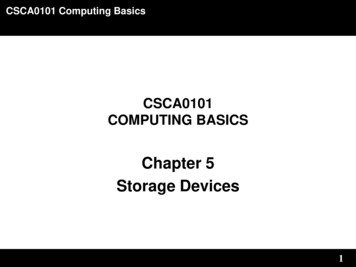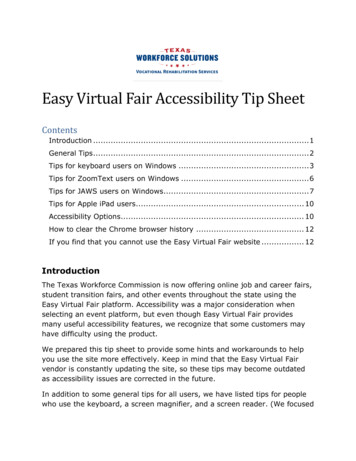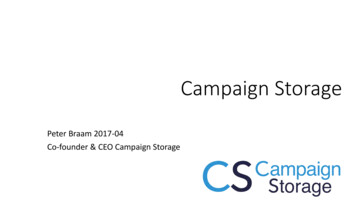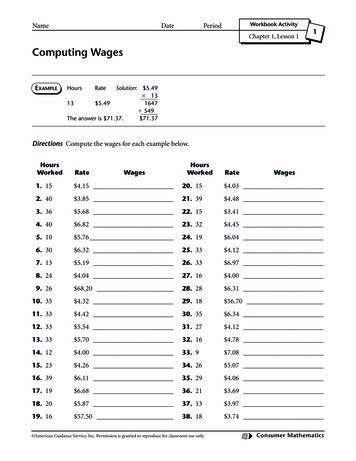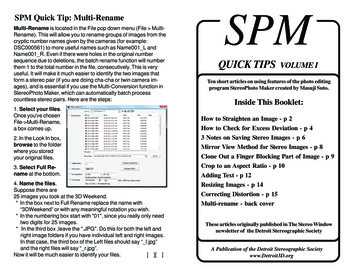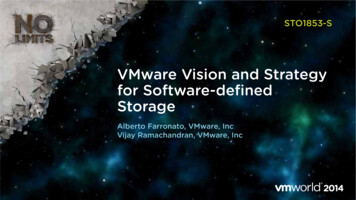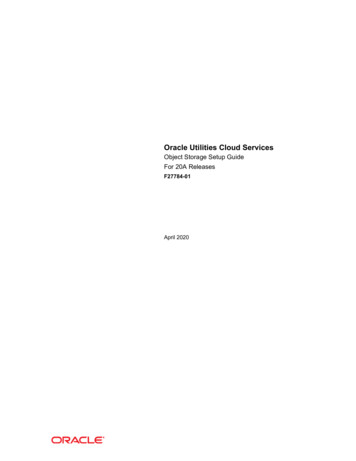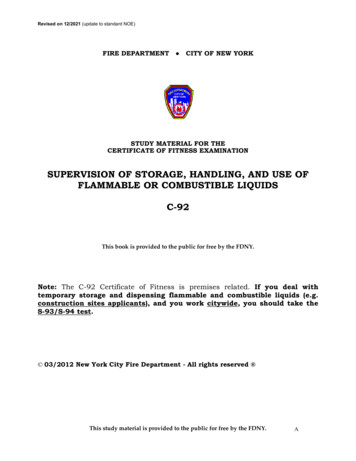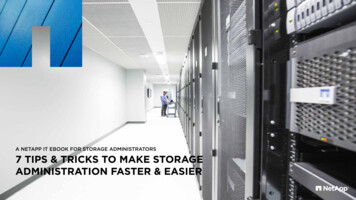
Transcription
A NETAPP IT EBOOK FOR STORAGE ADMINISTRATORS7 TIPS & TRICKS TO MAKE STORAGEADMINISTRATION FASTER & EASIER
7 Tips & Tricks to Make Storage AdministrationFaster & EasierBLOGS21: Introduction—Jeff Boni32: Automating cDOT Configuration: How to Make a 4-Hour Process Only 5 Minutes—Ezra Tingler43: The Importance of IO Density in Delivering Storage as a Service (Part 1)—Eduardo Rivera64: The Role of QoS in Delivering Storage as a Service (Part 2)—Eduardo Rivera85: The Demystification of NetApp Private Storage —Mike Frycz106: Using AltaVault and StorageGRID to Replace Tape Backups —Pridhvi Appineni127: How We Balanced Power & Capacity in Our Data Centers with Flash & Other Innovations—Randy Egger148: How NetApp Products Help NetApp IT Overcome Data Protection Challenges —Dina Ayyalusamy16
IntroductionJEFF BONI, VP FOUNDATIONAL SERVICES, NETAPP ITThe storage adminrole is changingrapidly thanks tovirtualization andautomation.The role of a storage administrator in IT is changingrapidly as virtualization and automation improveefficiency and productivity. These trends give face toa series of new challenges: storage service levels thatadjust to changing application performance/capacityrequirements and integration with other layers of the stack (compute,networking and the cloud). The new storage environment requires anew skill set that relies on proactive data analysis and looks to a future ofhyper-converged infrastructures and hybrid cloud.This ebook examines the many issues present in today’s storageenvironment. NetApp IT practitioners share their experiences, with anemphasis on the best practices IT has adopted to improve its servicedelivery to the business: Automating ONTAP configurations (ONTAP ) Designing storage service levels (OnCommand Insight/ONTAP) Adopting the hybrid cloud (Data Fabric)www.NetAppIT.com3 Demystifying NetApp Private Storage (NPS) for the hybrid cloud(NPS, Data Fabric) Replacing tape backup with cloud and object storage (AltaVault andStorageGRID ) Overcoming data protection challenges (Snap products, FlexClone )We invite you to take the next step and ask NetApp IT experts to sharetheir real experiences in using NetApp products and services, includingAll Flash FAS and OnCommand Insight, in the NetApp productionenvironment. Ask your NetApp sales team to arrange an interactivediscussion with us soon.Jeff Boni, VP Foundational Services,NetApp ITTwitter: @NetAppIT
Automating ONTAP Configurations: How to Make a4-Hour Process Only 5 MinutesEZRA TINGLER, SENIOR STORAGE ENGINEER, NETAPP ITI wrote a script todo a 4-hour storagecluster configurationin 5 minutes.As a senior storage engineer in our Customer-1organization, I am responsible for storage lifecyclemanagement including the installation, decommission,and capacity management of our ONTAP and 7-Modestorage controllers. Our group is in the midst of movingall data hosted on 7-Mode storage controllers to ONTAPstorage clusters.Business ChallengeAs part of our migration, we are installing additional ONTAP clusters andnodes. The configuration of each high availability (HA) pair took aboutfour hours, spread out over 2 to 3 days. The four hours did not include thetime needed to configure the cluster inter-connect switches or initializedisks; this takes 2 to 12 hours depending on disk type. Plus typicaloffice interruptions added more time as I had to figure out where I hadleft off. This sporadic schedule seemed to result in some configurationinconsistencies.The SolutionI challenged myself to see if I could automate the process to save timeand reduce errors. Although I’m not a developer, I found it easy to writethe script using the NetApp Software Development Kit (SDK). I run thewww.NetAppIT.com4script after the disks are initialized, cluster setup is complete, and thecluster inter-connect switches are properly configured. The script readsconfiguration information from a file, then applies the configuration to thecluster nodes. It does so by accessing the nodes via ZAPI calls, which iswhy it is fast.The results have been amazing. The four-hour process now takes aboutfive minutes to complete 99% of the configuration. It is now possibleto install 24 nodes in two hours rather than 96 hours, a time savings of94 hours or 2½ work weeks. Errors caused by interruptions have beeneliminated. Automating this process has freed up my time to work onother projects.If you are a storage admin, you can easily do this yourself with the SDK.I used an SDK tool called Z-Explorer that contains a complete list of allZAPI calls for the cluster. With Z-Explorer most of the development workis done for you. It took me just three weeks to automate all the builds.This KnowledgeBase article is a good place to start.It was a fun project because I could write the script without feeling like Ihad to be a developer. I wrote the scripts in PERL, but the SDK works withany language you are familiar with. I also used the SDK online forum toget advice from others. People were quick to answer my questions.Twitter: @NetAppIT
Automating cDOT Configuration:TheHowCIO’stoNewMakeRole:a 4-HourThe BusinessProcess ofOnlythe5BusinessMinutesThe FutureI’m now using the SDK to automate and streamline other storage tasks tosave time and reduce errors. My next project is a quality assurance (QA)script that will login to a cluster and verify if nodes are properly configuredper NetApp IT Standards and NetApp best practice guidelines. I plan toautomate the cluster interconnect switch configuration in the same way aswell as e-Series configuration.Read the story in the Tech ONTAP newsletter.Check out the NetApp Software Development Kit.Find the script in the NetApp Automation Store. Search: Day-0 c-modecluster build setup.Ezra Tingler, Senior Storage Engineer,NetApp ITwww.NetAppIT.com5Twitter: @NetAppIT
The Importance of IO Density in Delivering Storage asa Service (Part 1)EDUARDO RIVERA, SENIOR STORAGE ENGINEER, NETAPP ITCan NetApp IT deliver storage as a service?NetApp IT posed this question to itself more than a year ago. Our goalwas to find a new way to offer our business customers a method bywhich they could consume storage that not only met their capacityrequirements, but also their performance requirements. At the sametime, we wanted this storage consumption model to be presented as apredictive and easily consumable service. After consulting with enterprisearchitects for NetApp’s cloud provider services, we developed a storageservice catalog leveraging two main items: IO Density and NetAppONTAP’s QoS (quality of service).In this first part of this two-part blog, we will discuss how NetAppOnCommand Insight’s IO Density metric played a key role in the design ofour storage service catalog. (You can also hear this as a podcast.)The Role of IO DensityIO Density is a simple, yet powerful idea. The concept itself is not new,but it is essential to building a sound storage consumption model. Bydefinition, IO Density is the measurement of IO generated over a givenamount of stored capacity and expressed as IOPS/TB. In other words, IODensity measures how much performance can be delivered by a givenamount of storage capacity.www.NetAppIT.com6The next step instorage managementis storage servicedesign.[Here’s an example of how IODensity works. Suppose wehave a single 7.2K RPM drive. Byrule of thumb, a single drive ofthis type can deliver around 50IOPS @ 20ms response time.Consider, however, that 7.2KRPM drives today can range anywhere from 1TB to 8TB in size. The abilityof the drive to deliver 50 IOPS does not change with its size. Therefore, asthe size of the drive increases, the IOPS/TB ratio worsens (i.e. you get 50IOPS/TB with 1TB drive and 6.25 IOPS/TB with an 8TB drive).Applying the same logic, we can divide the amount of capacity that weprovision to a given application by the amount of IO that an applicationdemands from its storage. The difference is that at the array level, thereare many other technologies and variables at play that can determinethe IO throughput for a given storage volume. Elements like disk type,controller type, amount of cache, etc., affect how many IOPS a storagearray can deliver. Nonetheless, the general capabilities of a known storagearray configuration can be estimated with a good degree of accuracygiven a set of reasonable assumptions.]Twitter: @NetAppIT
The Importance of IO DensityThe CIO’sin NewDeliveringRole: TheStorageBusinessas a Serviceof the Business(Part 1)Using OnCommand Insight we were able to gather, analyze, andvisualize the IO Density of all the applications that run on our storageinfrastructure. Initially, what we found was surprising. Some applicationsthat anecdotally were marked as high performance were demonstratingvery low IO Density rates, and thus were essentially wasting highperformance storage capacity. We also saw the reverse, whereapplications were pounding the heck out of lower performance arraysbecause their actual IO requirements were incorrectly estimated at thetime of deployment. Therefore, we started to use NetApp OnCommandInsight’s aggregated IO Density report to profile application performanceacross the entire infrastructure and establish a fact-based architecture.Ultimately, OnCommand Insight’s IO Density report helped us to identifythe range of service levels (defined as IOPS/TB) that the apps actuallyneeded. With this information, we created a storage catalog based onthree standard service levels:99 percent of our installed base. Those workloads requiring somethingother than these pre-defined workloads are easily dealt with on a caseby-case basis since there are so few of them.A New Perspective on of Application PerformanceIO Density gave us a new perspective on how to profile and deployour applications across our storage infrastructure. By recognizing thatperformance and storage capacity go hand in hand, we were able tocreate a storage catalog with tiers that reflected the actual requirementsof our installed base.Our next step was placing IO limits on volumes to prevent applicationsfrom stepping on the performance resources of other applications withinthe same storage array. Stay tuned for part two of this blog where I willdiscuss how we used ONTAP’s adaptive QoS feature to address this issue.Tune into the Tech ONTAP podcast for more details.1. Value: Services workloads requiring between 0 and 512 IOPS/TB.2. Performance: Services workloads requiring between 512 and 2048IOPS/TB.3. Extreme: Services workloads requiring between 2048 and 8192IOPS/TB.Based on our own understanding of our application requirements (asdepicted by our IO Density reports), the above three tiers would addressEduardo Rivera, Senior Storage Engineer,NetApp ITwww.NetAppIT.com7Twitter: @NetAppIT
The Role of QoS in Delivering Storage as a Service(Part 2)EDUARDO RIVERA, SENIOR STORAGE ENGINEER, NETAPP ITUsing ONTAP QoSpolicies we can moreefficiently manageour storage servicelevels.NetApp IT is on a journey to offer its customers storageas a service. In part one of this blog, I discussed howwe embraced IO Density to help us better profileand deploy our applications across our storageinfrastructure. We developed a three-tier servicecatalog that offers storage as a predictive and easilyconsumable service to our customers. The second step in this journey wastapping into the power of clustered Data ONTAP ’s adaptive Quality ofService (QoS) feature to assure performance stability.QoS—Corralling the HerdThe adoption of ONTAP’s QoS feature is a key component of our storageas-a-service model. In a nutshell, QoS enables us to place IO limits onvolumes (it can also work at the storage virtual machine (SVM) or filelevel) in order to keep the applications using those volumes within theirIOPS “swim lane.” This prevents one application from starving otherapplications of performance resources within the same storage array. QoScan be implemented dynamically and without interruption to applicationdata access.enforce a particular IOPS/TB objective. Hence, if we have a volume thatis consuming 1TB of capacity and the service level objective (SLO) is toprovide 2048 IOPS/TB, the QoS policy for that volume would set an IOPSlimit of 2048. If that same volume in the future grows to 2TB of consumedspace, then the QoS policy would be adjusted to 4096 IOPS/TB tomaintain an effective 2048 IOPS/TB. In a live environment with hundreds,or even thousands, of individual volumes and where storage consumptioncontinuously varies (as the application writes/deletes data), manuallymanaging all the QoS policies would be close to impossible. This is whereAdaptive QoS comes in.Adaptive QoS is a tool developed by NetApp. Its sole purpose is tomonitor consumption per volume and dynamically adjust each volume’sQoS policy so that it matches the desired IOPS/TB SLO. With this tool,we are able to provision volumes at will and not worry about having tomanage all the necessary QoS policies.With QoS and Adaptive QoS, we are able to easily provide predictivestorage performance tiers upon which we can build the actual storageservice catalog.In our storage catalog model, we assign a QoS policy per volume for allthe volumes that exist within a given cluster. The QoS policies themselveswww.NetAppIT.com8Twitter: @NetAppIT
The Role Theof QoSCIO’sin NewDeliveringRole: TheStorageBusinessas a Serviceof the Business(Part 2)Building the Storage Service CatalogData-Driven DesignWith the pre-defined service levels and the ability to manage IO demandwith Adaptive QoS, we were able to build a storage infrastructure thatnot only delivers capacity but also predicts performance. LeveragingONTAP’s ability to cluster together controllers and disks that offervarious combinations of capacity and performance, we built clustersusing different FAS and AFF building blocks to deliver varying tiers ofperformance. Then Adaptive QoS was used to enforce the performanceSLO per volume depending on where that volume resides.Together, IO Density and QoS have revolutionized how we view ourstorage. It has made us much more agile. The IO Density metric forces usto think about storage in a holistic manner because we operate accordingto a data-driven—not experience-based—storage model. We don’t needto look at whether we have enough capacity or performance, but cancheck to see if we have enough of both. If we nail it, they run out at thesame time.Moving a volume between service levels is also quite simple usingONTAP’s vol-move feature. Adaptive QoS is smart enough to adjustthe policy based on where the volume sits. By defining a service levelper aggregate, we are also defining a multitude of service levels withina particular cluster through which we can move our data around.Addressing changes in performance requirements is easy; we move thevolume to a higher performing high availability (HA) pair using vol-move.The same is true with the QoS service level approach. Our storageinfrastructure is much simpler to manage. ONTAP gives us granularcontrol of resources at the volume level; our QoS policies now act as thecontroller. Best of all, this new storage approach should enable us todeliver a storage service model that is far more cost efficient than in thepast while supporting application performance requirements.Tune into the Tech ONTAP podcast for more details.Eduardo Rivera, Senior Storage Engineer,NetApp ITwww.NetAppIT.com9Twitter: @NetAppIT
The Demystification of NetApp Private Storage (NPS)for CloudMIKE FRYCZ, BUSINESS SYSTEMS ANALYST, IT SUPPORT & OPERATIONS, NETAPP ITIf you follow NetApp IT, you’ll know that we talk a lot about our hybridcloud strategy and roadmap. But one question comes up repeatedly: Howdo we operationalize the cloud? How does our cloud strategy translateinto operational excellence, especially when it comes to taking advantageof hyperscaler cloud resources?Our FAS system is physically deployed in racks located inside a NetAppcage, similar to that shown. The minimum is two nodes for highavailability. The FAS system is managed by an off-site storage team.Our current cloud operations are actually fairly simple. They rely on threeprimary elements: NetApp Private Storage (NPS) for Cloud enables us to access cloudresources while maintaining complete control over our data. Cloud-connected colocation facilities, such as Equinix, allow the datato remain private just outside the cloud. Hyperscalers, such as Amazon Web Services (AWS), Microsoft Azure,and others offer flexible compute resources.NPS for Cloud ArchitectureTo better understand what this all means, let’s look at the physicalarchitecture of NetApp IT and NPS for Cloud, as shown in the graphic.NetApp’s FAS system connects to the AWS and Azure compute via adedicated network connection within an Equinix data center. We willconnect to other hyperscalers in the future.www.NetAppIT.com10Twitter: @NetAppITThe FAS system connects to a layer 3network switch, patched to an Equinixpatch panel through a cross connect.The Equinix cross-connect uses singlemode fiber (SMF) optic cables thatrun through a large, yellow overheadtray and down the aisles of the Equinixfacility to the cloud peering switch inthe AWS and Azure cages.
The DemystificationThe CIO’sof NetAppNew Role:PrivateThe BusinessStorage (NPS)of the forBusinessCloudThe cable directly connects to AWSand Azure inside their respective cages.Given the close physical proximity of thestorage and data to the hyperscaler, wenow can access a high bandwidth (10GB)Ethernet connection from our data centerby way of NPS to the cloud.Our data resides in NetApp storage,but our compute is accessed in AWS orAzure. We currently operate our legal,human resources, branding, customerservice support, and various otherportals using NPS for Cloud.Keeping Control of Our DataIs NPS for Cloud really that simple? Yes. And its benefits are numerous: Ability to keep control of data at all times High-throughput, direct connections to the cloud Ability to rapidly scale our compute or secure run-time resources forpeak workloads Centralized storage intelligence using OnCommand Insight and datamanagement through NetApp ONTAP software Compliance with the security and privacy requirements of companiesand governments Migration flexibility so applications can be easily moved betweendifferent cloudsOur next phase is to work with Business Apps to build cloud-aware appsthat take advantage of the many benefits of the cloud, such as platformas-a-service (PaaS) and DevOps. The cloud is definitely a key part of ourstrategy to excel at IT service delivery inside NetApp.Download the infographic from NetAppIT.com.The single most important benefit to NetApp IT of using NPS for Cloudis that we keep control of our data. We use the SnapMirror feature ofONTAP to replicate the data from our on-premises data centers to NPSthen to AWS or Azure. The NetApp Data Fabric enables us to connectto and switch cloud providers at any time. We avoid vendor lock-in andcostly data migrations.www.NetAppIT.com11Twitter: @NetAppITMike Frycz, Business Systems Analyst, IT Support &Operations, NetApp IT
Using AltaVault and StorageGRID to ReplaceTape BackupsPRIDHVI APPINENI, SENIOR MANAGER, IT STORAGE SERVICES, NETAPP ITOne of the business challenges NetApp IT faces is archiving our legal,finance, and Sarbanes-Oxley (SOX) compliant data. Backing up thisdata is important for legal, HR, and tax reasons. In some cases, the datamust be secured for seven years for tax purposes. Like most companies,we have relied on tape backups to secure this data. Tapes are reliable,inexpensive, and present very little risk to our operations.My IT storage team was intrigued by the use case that NetApp AltaVault and NetApp StorageGRID offered. AltaVault cloud-integratedstorage functions as a cloud gateway for backup and archive applications.StorageGRID provides an enterprise-grade object storage solutionthat supports widely adopted cloud protocols such as Amazon S3. Thecombination of AltaVault and StorageGRID would enable us to efficientlyback-up application data while optimizing data protection and simplifyingdisaster recovery.NetApp IT’s core tenet is to adopt technologies only when they satisfya business use case. We evaluated these products and came to theconclusion that AltaVault and StorageGRID would be a powerfulcombination to modernize our backup procedures, reduce our costs, and,most importantly, improve the speed with which we can restore data forour customers.www.NetAppIT.com12The business casefor using AltaVaultand StorageGRID toreplace tape backupsis compelling.Powerful CombinationBecause they take advantageof the cost and scale benefitsof cloud storage, AltaVault andStorageGRID are designed foran enterprise like NetApp withlocations worldwide.AltaVault delivered benefitssuch as 30:1 inline deduplication,compression and encryption technology, which makes archived dataeasier to transport and store, and faster to retrieve. It offers completesecurity for the data. We can categorize that data into buckets to make itmore easily retrievable. We are currently seeing 22 times deduplicationsavings from the data stored in AltaVault. As we push more data throughAltaVault, we will benefit from even greater savings.StorageGRID enables us to store and manage these massive datasets in arepository in the hybrid cloud. It enables us to abstract storage resourcesacross multiple logical and/or physical data centers. We also create datapolicies to manage and protect our data according to our requirements.Twitter: @NetAppIT
Using AltaVaultThe CIO’sandNewStorageGRIDRole: The toBusinessReplaceofTapethe BusinessBackupsChanging Our Archiving ArchitecturePreviously, critical data from all our locations was backed up in ourSunnyvale, California data center. We use backup software to manage theflow of the data from backup storage into a tape library in Sunnyvale. Wedefined when and how the archiving took place. The tapes were regularlytransported to an off-site location for safekeeping. When data neededto be restored, we had to order the tapes from the vendor and physicallytransport them back to our site, which took at least 24 hours.Under the new target architecture, the process remains virtually the same.First, AltaVault provides a local optimized disk cache for the applicationto store backup data, resulting in faster restores for end users and savingbandwidth. One copy is stored in the StorageGRID nodes in Sunnyvale.Then the data is copied to StorageGRID nodes in our Raleigh, NorthCarolina data center, which serves as a repository for the offsite datacopy. The complete cutover process took about five months.We also gained flexibility. We can more easily modify archive policies andadd new archives on an ad-hoc basis. AltaVault allows us to scale ourarchive/SOX environment much faster than we could with a tape library.For example, we can spin up a virtual machine with AltaVault usingexisting disk shelves to gain capacity as opposed to purchasing moretape drives and a new frame for the tape library. Long term, the combinedsoftware will make it much easier to transition our backup procedures tonew data centers as our data center footprint evolves.Faster, More Reliable Data ArchivingOne of the most satisfying parts of this project has been seeing firsthandthe impact NetApp products can have on our operations. Not only willwe improve efficiency and reduce costs, but we also will improve thedata archiving services we provide to our business customers. As a teamthat constantly strives to use the best technologies to improve servicedelivery, that is the best result of all.The benefits have been numerous. We eliminated the cost oftransportation, storage, tape library support, and physical tapeprocurement. Bringing backup in-house has enabled us to automatemany of the day-to-day operational processes, resulting in a moreagile service. We can also retrieve the archived data in one to six hours,depending on the data set size, or 3 times faster than before. Thistranslates to a much faster turnaround for our customers. We anticipateimproved backup speeds and significant cost savings in the futurewww.NetAppIT.com13Twitter: @NetAppITPridhvi Appineni, Senior Manager, IT Storage Services,NetApp IT
How We Balanced Power & Capacity in Our DataCenters with Flash & Other InnovationsRANDY EGGER, DATA CENTER LEAD, NETAPP ITOne of the biggest trade-offs in any data center is power and capacity,the two biggest expenses of any data center. The golden rule is that thesetwo costs increase together—the more racks of hardware you have, themore power you need to run it. This means when you need more capacity,you need more power, which could result in a cooling issue. If you haveenough cooling and power, you could run out of rack capacity.NetApp IT was able to address the power and cooling costs in amultitude of ways. We started by making changes to the facility itself. Weinstalled non-traditional raised floors. We introduced overhead cooling,economization, and cold aisle containment over six years ago. Thesechanges have helped control our power and cooling costs.Changing Relationship between Power and CapacityA NetApp IT data center operation analysis compiled over the pastdecade shows that the relationship between power and capacity isevolving due to other factors as well. We are seeing that while ourcompute and storage capabilities are increasing, our power costs havebeen actually dropping. This shift is due to several reasons: the availabilityof the cloud, smaller form factors offering more horsepower, andvirtualization, among others.www.NetAppIT.com14The chart illustrates this point. Our power requirements peaked in mid2011 when we opened a new NetApp production data center, the HillsboroData Center (HDC). As we moved operations into HDC and closed otherdata centers, power consumption dropped while storage and computeincreased significantly. Since then we’ve seen this trend continuing.The following factors are contributing to this change: Virtualization. In the past, each app had its set of hardware andits own power supply, which translated to thousands of servers, anexpensive model to maintain. Because of virtualization, the sameapplications can be hosted on 10 to 20 physical machines in a fewracks using around 20 kilowatts (kW). NetApp IT’s compute is 75%virtualized now. All Flash FAS adoption. Our solid-state disks (SSD) take very littlepower (1-2kW as compared to 5-6kW for traditional disks per rack);our Flash hardware even less. As result, full storage racks aren’t evenclose to reaching their power limits. Using Flash for all non-archivalstorage going forward means even lower power consumption. High-density storage rack design. HDC has high-density, tallerthan-normal racks, 52U as opposed to traditional 42U or 47U rackswith more power (10kW/rack). Hardware that used to take four racksTwitter: @NetAppIT
How We BalancedThe CIO’sPowerNew Role:and CapacityThe Businessin Ourof Datathe BusinessCenters now takes half of a rack, thanks to higher density disks and higher IOcapability clusters/filers. This unique design has reduced the numberof infrastructure/connection points, shrinking the data center footprintand enabling a build-as-you-grow approach.continue, even as we begin to take advantage of the hybrid cloud. Insteadof building arrays to meet peak workloads--which translates to idlecapacity--we will be able to take advantage of the cloud’s elasticity. This,in turn, will reduce operational, licensing, and management costs.FlexPod datacenter. We have eight FlexPod systems hostinghundreds of applications in a rack connected to the Cisco fabric fornetworking and compute. The applications are hosted on thousandsof machines, but thanks to virtualization and cloud, that doesn’t meanthousands of physical servers. Most of the applications are hosted onvirtual machines. These footprints will continue to shrink as computecore processor power increases, hardware size shrinks, and powerconsumption requirements fall due to technology advancements.Adopting a hardware lifecycle management strategy is a key factor inreducing power consumption and improve capacity management. In ourHDC migration, we were able to decommission 96 of 163 systems and 40filers (of 2 PB of storage); more than 1,000 servers were either migratedor decommissioned. The configuration management database (CMDB),NetApp IT’s single source of truth for everything in IT operations, alsoplays a major role in helping us track, manage, and analyze power andcapacity over time. Smart power design. The Starline busway system supports ‘anywhere’power and connector types, and with our smart layout we can utilizepower borrowing that enables us to share power across multiple racks.We can draw power from a parallel busway if a rack needsmore than 9kW. We have effectively removed power as acapacityconsideration in our hardware installations.While ouris increasing, ourpower costs aredropping.Each company faces its own challenges in controlling its powerconsumption costs while maximizing its storage and compute. However,as we have seen, adopting a hardware lifecycle management strategyand leveraging innovations in technology and power design can make asignificant difference.Our analysis shows that the relationship between storage/compute capacity to deliver applications and power willRandy Egger, Data Center Lead, NetApp ITwww.NetAppIT.com15Twitter: @NetAppIT
How NetApp Products Help NetApp IT OvercomeData Protection ChallengesDINA AAYYALUSAMY, LEAD DATABASE ADMINISTRATOR, NETAPP ITAs a database administrator (DBA), I face very different challenges thanI did five years ago. The adoption of the hybrid cloud, rising securityand backup concerns, and the expectation of non-disruptive service arerapidly changing the IT environment. Like many IT shops, NetApp IT isdoing more with less, including supporting a large number of databases(400 plus) on a smaller budget.While performancemanagement rema
per NetApp IT Standards and NetApp best practice guidelines. I plan to automate the cluster interconnect switch configuration in the same way as well as e-Series configuration. Read the story in the Tech ONTAP newsletter. Check out the NetApp Software Development Kit. Find the script in the NetApp Automation Store. Search: Day-0 c-mode
